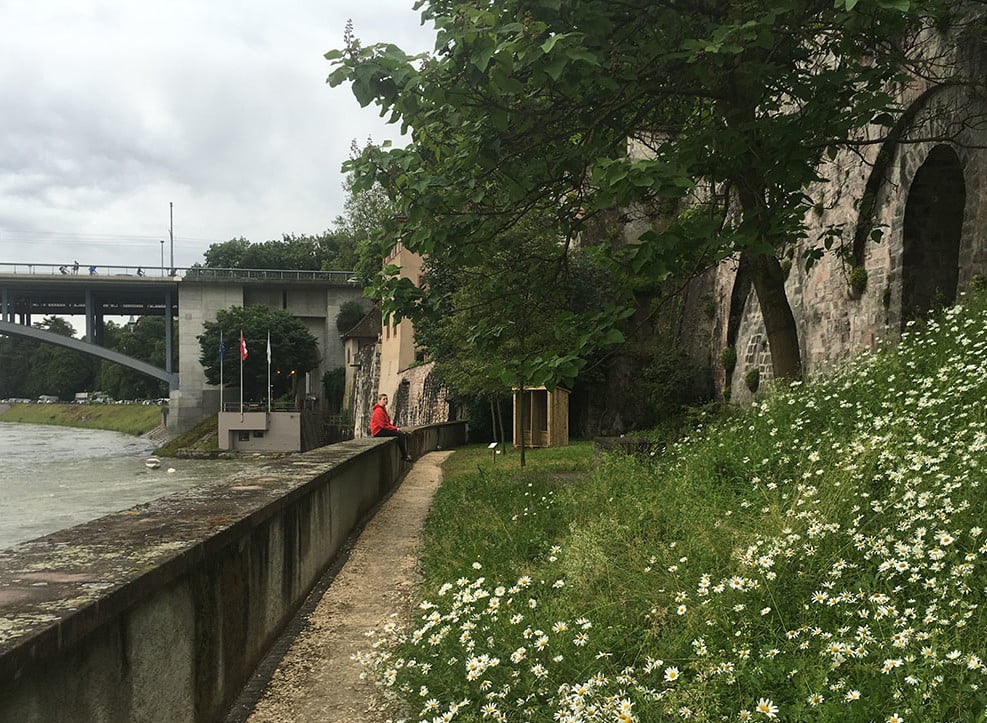Art Fairs
Sitting in ‘The Toilet on the River’ at Art Basel
The witty installation is a much-needed break from the pomp of the fair.

The witty installation is a much-needed break from the pomp of the fair.

Rozalia Jovanovic

Sitting in the Toilet on the River, a work by Russian émigré artists Ilya and Emilia Kabakov, I watched the Rhine violently rush by. The cacophonous main exhibition hall of Art Basel was only a few tram stops away, but my thoughts (about artwork and booths and record-breaking sales) momentarily gave way to the surprising and obliterating force of the water.
The Toilet on the River is an installation in the Parcours section of the fair, a network of 19 free-standing installations curated by Samuel Leuenberger around Munsterplatz, the plaza around Basel’s historic red sandstone cathedral on the hill, parts of which date back to the 11th century. To reach the Kabakovs’ work, viewers must descend four flights of ancient stone steps and walk along the banks of the Rhine onto a grassy area where the outhouse sits.
The Kabakovs created their temporary structure from weathered wooden boards nailed together. The wood was clean, raw, and smelled faintly of cedar. The seat of the toilet had a dark hole, which could have functioned as a toilet, though thankfully no one had interacted with the artwork that way. There were no doors on the two stalls, which were angled to give a perfectly framed view of the river. The only other person there during my visit was the docent, who stood silently a few dozen feet away.
“Being in a bathroom and daydreaming in nature are two sides of the same experience,” wrote Ilya Kabakov in the intro in the Parcours pamphlet that I read while sitting in The Toilet on the River. “Quiet meditative states. One is alone in isolation from the frustrating social world with a marvelous feeling of solitude, tranquility, and peace.”
It sounded like the perfect antidote to fair exhaustion, but before long my mind eventually wandered back to the fair and to the 1989 Mike Kelley installation, Reconstructed History, a series of 50 sexually explicit drawings on the pages of old textbooks that Kelley had defaced with a schoolboy’s glee. I was there at the exhibition’s opening and watched as collector Peter Brant walked though and paused to scrutinize each one. Later, it would be announced that the entire Mike Kelley installation had been sold for $1.5 million to a “private American collection.”
I had just heard that Artnews SA (the former parent company of ARTnews and Art in America), which Brant had acquired a 47.6 percent stake in in 2015, had filed for bankruptcy. “But nobody knows what it means,” one dealer said to me. Last month, his BMP Holdings took control of ARTnews and Art in America.
Sitting in The Toilet on the River, I thought of how the Kabakov outhouse was an ennobling counterpoint to the pomp of the fair and the massive size of so many of the installations—like Paul McCarthy’s perverted Tomato Head (Green), an adult version of the children’s toy Mr. Potato Head, featuring a sculpture of a man, nude from the waist down, wearing a tomato on his head and surrounded by pieces like carrots, blocks, and rakes that visitors could insert into his body. The work had been sold for $4.75 million to a private American collection.
A few days later, Brett Gorvy, Christie’s chairman and international head of post-war and contemporary art, would post to Instagram a suggestive picture of himself standing in the installation holding a carrot near the sculpture’s backside.
The toilet has been many things to many artists, I thought, sitting in The Toilet on the River. Marcel Duchamp turned a urinal upside down and transformed it into a work of art, rendering it useless. In 1996, Sarah Lucas placed a functioning toilet in an empty room at Contemporary Fine Arts, Berlin. The toilet had been an ongoing object of fascination for the artist, who had also cast one in resin and, for another work, took a picture of herself sitting on one, smoking. She claimed the work had to do with self-destruction and the impulse toward sex and death.
In 2016, Maurizio Cattelan upped the ante with the promise of fully functional toilet cast in solid gold, entitled America. This much-anticipated commode was supposed to be at the disposal of the public at the Guggenheim Museum this past May, during Frieze New York, but its debut was delayed, indefinitely.
The toilet by the Kabakovs was more humble and hopeful. It was less concerned with toilets as receptacles of waste or as baubles for the one percent and more interested in the safe spaces they provide. As I sat in The Toilet on the River gazing out on the water, I liked its humility. The Rhine was opalescent green and made a steady, faintly discomfiting whoosh, interrupted only where the water crashed against the banks and broke into white foam.
As I made my way up the stairs and back to the fair, I passed a woman who had also made the pilgrimage to the outhouse. “It’s just a wooden box,” she said to me, seemingly frustrated for having had to walk all those stairs. That it is. But it’s a wooden box that is witty and charming, and offered one of the best views from the fair.